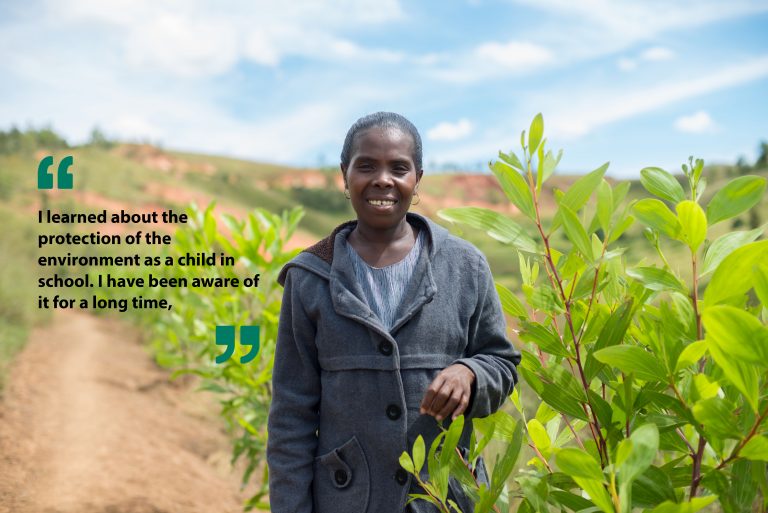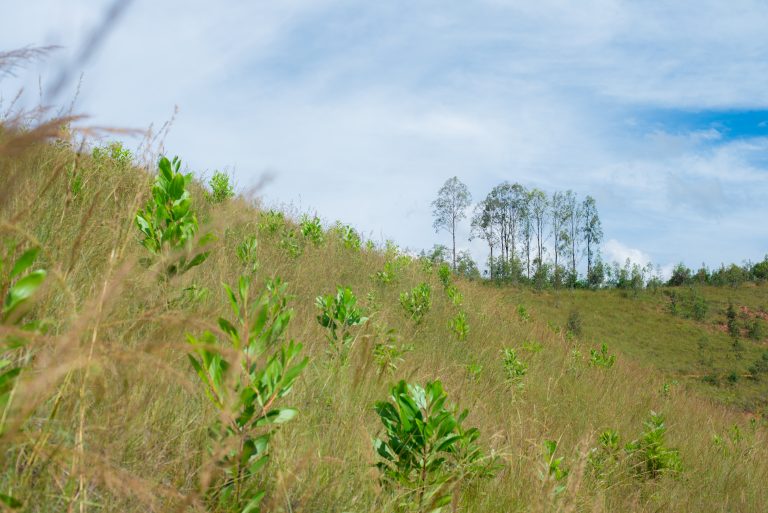This Land is Our Land
Local couple plant trees to fight erosion
When David and Mary look out across their property, they don’t just see rice fields in the valley and acacia seedlings dotting the hillside. They see a rich and green future for their six children and all subsequent generations.
Two years ago, the husband and wife in the agricultural community of Mirarisoa, in Ambalavao District, never imagined such an alternative. They saw only low-yield rice fields and eroded hillsides sloughing soil down into the farms below. They saw a future where their grandkids would continue to toil in the boiling heat and desiccated earth.
“The challenge in this area is the environment is already destroyed,” Mary said. “If the erosion continues, it will destroy our rice field in the valley. It will be covered with earth.”
When ASOTRY field agents visited Mirarisoa, they saw a community on the brink of environmental collapse. Though the farmers lacked proper farming techniques and business training, and their families suffered from food insecurity, early change needed to start with reforestation.
Farmer Field Schools would improve the quality of the rice, but it would not prevent the dry, eroded soil from destroying it.
“When we heard about the objective of the project to fight against food insecurity, we were very interested,” Mary said. “That is one of the issues we face here, and many members of the community were very interested.”
The ASOTRY training began with a wide range of topics related to farming, business, health, and education, but the foundation was always reforestation.
“When the project trained us about tree planting, we were interested because I saw the value for the environment,” David said. “The hills here are already bare, and we saw it would improve the soil. Reforestation protects the soil from erosion and it also helps the management of water. When there are trees, it retains the water.”
David wanted his family to be examples of the value of reforestation. In fact, the 41-year-old father and farmer has wanted to protect the environment ever since he was a boy, but he always lacked proper training and tools.
“I learned about the protection of the environment as a child in school. I have been aware of it for a long time,” he said. “I even tried to plant trees in my field before, but it turns out I was not planting the right type of tree—eucalyptus dries out the soil, and the project taught us to plant the acacia tree, which is better for the soil because it retains the water under the ground.”

When ASOTRY field agents asked for volunteers to offer their land for reforestation, David and Mary were quick to sign up.
“When the technicians came here, they taught us the bad effect of deforestation on the environment and they asked if some of us were willing to plant seedlings,” Mary said. “We agreed because we are aware of the destruction of the environment.”
Once volunteers like David and Mary were identified, the project provided seedlings, tools, and offered commodity incentives to local tree planters.
Within two days, the hillside overlooking David and Mary’s rice field was home to nearly 3,000 acacia seedlings. The following year, the couple decided they wanted even more trees on their property. Without the support of their community or hired workers, the family of 8 planted 2,500 additional seedlings. It took them one month.
“We had to have a very good schedule because we planted the trees and we also had to work in the rice field,” Mary remembered. “We were very tired by the end of the month.”
But the effort paid off: now their hillside has more than 5,000 seedlings that continue to grow. Within five years, they will be about ten meters tall, and the whole hillside will be transformed from the dry, baked brown of the past into a leafy, green forest.





